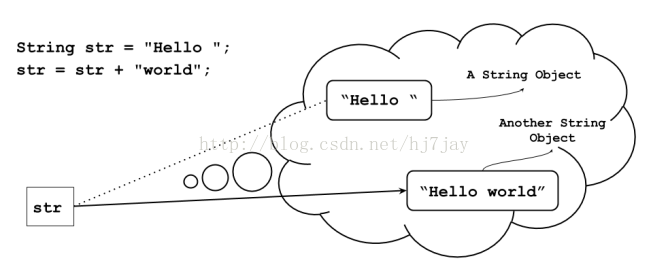前言
在Java开发者中,字符串的拼接占用资源高往往是热议的话题.
让我们深入讨论一下为什么会占用高资源。
在Java中,字符串对象是不可变的,意思是它一旦创建,你就无法再改变它。所以在我们拼接字符串的时候,创建了一个新的字符串,旧的被垃圾回收器所标记。

如果我们处理上百万的字符串,然后,我们就会生成百万的额外字符串被垃圾回收器处理。
在大多数的教程中,也许你会看到用+号拼接字符串会生成多个String,导致性能过差,建议使用StringBuffer/StringBuilder来拼接。
可是真的是这样的吗?
本文在JDK8中做了如下实验:
public static void main(String[] args) {
String result = "";
result += "some more data";
System.out.println(result);
}
通过javap -c来反编译得到:
Code:
0: aload_0 // Push 'this' on to the stack
1: invokespecial #1 // Invoke Object class constructor
// pop 'this' ref from the stack
4: return // Return from constructor
public static void main(java.lang.String[]);
Code:
0: ldc #2 // Load constant #2 on to the stack
2: astore_1 // Create local var from stack (pop #2)
3: new #3 // Push new StringBuilder ref on stack
6: dup // Duplicate value on top of the stack
7: invokespecial #4 // Invoke StringBuilder constructor
// pop object reference
10: aload_1 // Push local variable containing #2
11: invokevirtual #5 // Invoke method StringBuilder.append()
// pop obj reference + parameter
// push result (StringBuilder ref)
14: ldc #6 // Push "some more data" on the stack
16: invokevirtual #5 // Invoke StringBuilder.append
// pop twice, push result
19: invokevirtual #7 // Invoke StringBuilder.toString:();
22: astore_1 // Create local var from stack (pop #6)
23: getstatic #8 // Push value System.out:PrintStream
26: aload_1 // Push local variable containing #6
27: invokevirtual #9 // Invoke method PrintStream.println()
// pop twice (object ref + parameter)
30: return // Return void from method
可以看到Java编译器优化了生成的字节码,自动创建了一个StringBuilder,并进行append操作。
由于构建最终字符串的子字符串在编译时已经已知了,在这种情况下Java编译器才会进行如上的优化。这种优化称为a static string concatenation optimization,自JDK5时就开始启用。
那是否就能说明在JDK5以后,我们不再需要手动生成StringBuilder,通过+号也能达到同样的性能?
我们尝试下动态拼接字符串:
动态拼接字符串指的是仅在运行时才知道最终字符串的子字符串。比如在循环中增加字符串:
public static void main(String[] args) {
String result = "";
for (int i = 0; i < 10; i++) {
result += "some more data";
}
System.out.println(result);
}
同样反编译:
Code:
0: aload_0 // Push 'this' on to the stack
1: invokespecial #1 // Invoke Object class constructor
// pop 'this' ref from the stack
4: return // Return from constructor
public static void main(java.lang.String[]);
Code:
0: ldc #2 // Load constant #2 on to the stack
2: astore_1 // Create local var from stack, pop #2
3: iconst_0 // Push value 0 onto the stack
4: istore_2 // Pop value and store it in local var
5: iload_2 // Push local var 2 on to the stack
6: i2d // Convert int to double on
// top of stack (pop + push)
7: ldc2_w #3 // Push constant 10e6 on to the stack
10: dcmpg // Compare two doubles on top of stack
// pop twice, push result: -1, 0 or 1
11: ifge 40 // if value on top of stack is greater
// than or equal to 0 (pop once)
// branch to instruction at code 40
14: new #5 // Push new StringBuilder ref on stack
17: dup // Duplicate value on top of the stack
18: invokespecial #6 // Invoke StringBuilder constructor
// pop object reference
21: aload_1 // Push local var 1 (empty String)
// on to the stack
22: invokevirtual #7 // Invoke StringBuilder.append
// pop obj ref + param, push result
25: ldc #8 // Push "some more data" on the stack
27: invokevirtual #7 // Invoke StringBuilder.append
// pop obj ref + param, push result
30: invokevirtual #9 // Invoke StringBuilder.toString
// pop object reference
33: astore_1 // Create local var from stack (pop)
34: iinc 2, 1 // Increment local variable 2 by 1
37: goto 5 // Move to instruction at code 5
40: getstatic #10 // Push value System.out:PrintStream
43: aload_1 // Push local var 1 (result String)
44: invokevirtual #11 // Invoke method PrintStream.println()
// pop twice (object ref + parameter)
47: return // Return void from method
可以看到在14的时候new了StringBuilder,但是在37的时候goto到了5,在循环过程中,并没有达到最优化,不断在生成新的StringBuilder。
所以上述代码类似:
String result = "";
for (int i = 0; i < 10; i++) {
StringBuilder tmp = new StringBuilder();
tmp.append(result);
tmp.append("some more data");
result = tmp.toString();
}
System.out.println(result);
可以看到不断生成新的StringBuilder,并且通过tostring,原来的StringBuilder将不再引用,作为垃圾,也增加了GC成本。
所以,在实际的使用中,当你无法区分字符串是静态拼接还是动态拼接的时候,还是使用StringBuilder吧。
Reference:
http://www.pellegrino.link/2015/08/22/string-concatenation-with-java-8.html
总结
以上就是这篇文章的全部内容了,希望本文的内容对大家的学习或者工作具有一定的参考学习价值,如果有疑问大家可以留言交流,谢谢大家对亿速云的支持。
免责声明:本站发布的内容(图片、视频和文字)以原创、转载和分享为主,文章观点不代表本网站立场,如果涉及侵权请联系站长邮箱:is@yisu.com进行举报,并提供相关证据,一经查实,将立刻删除涉嫌侵权内容。